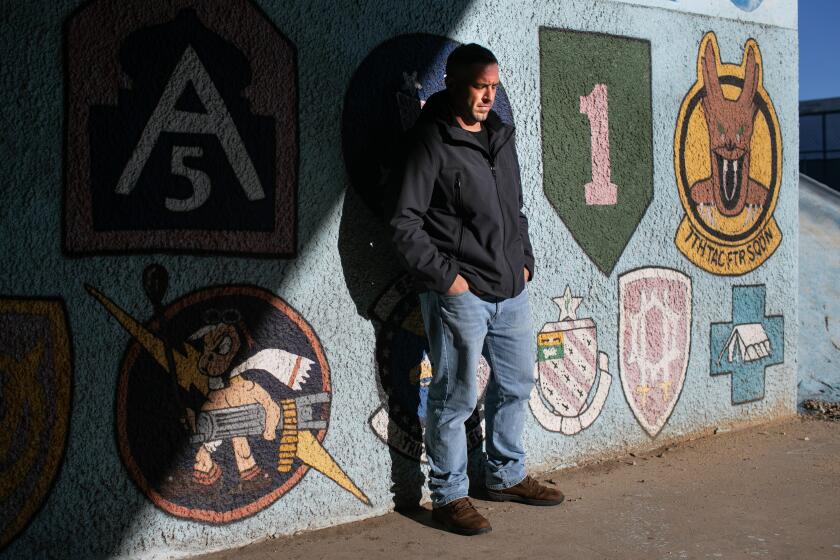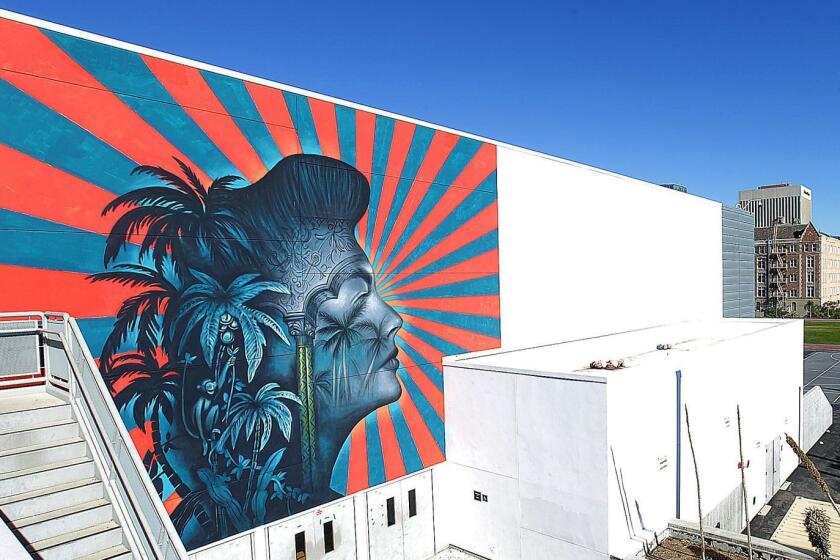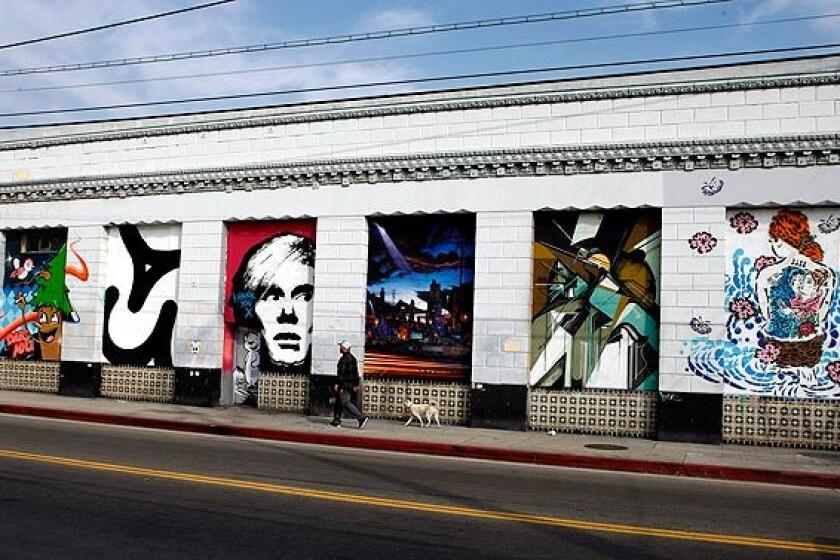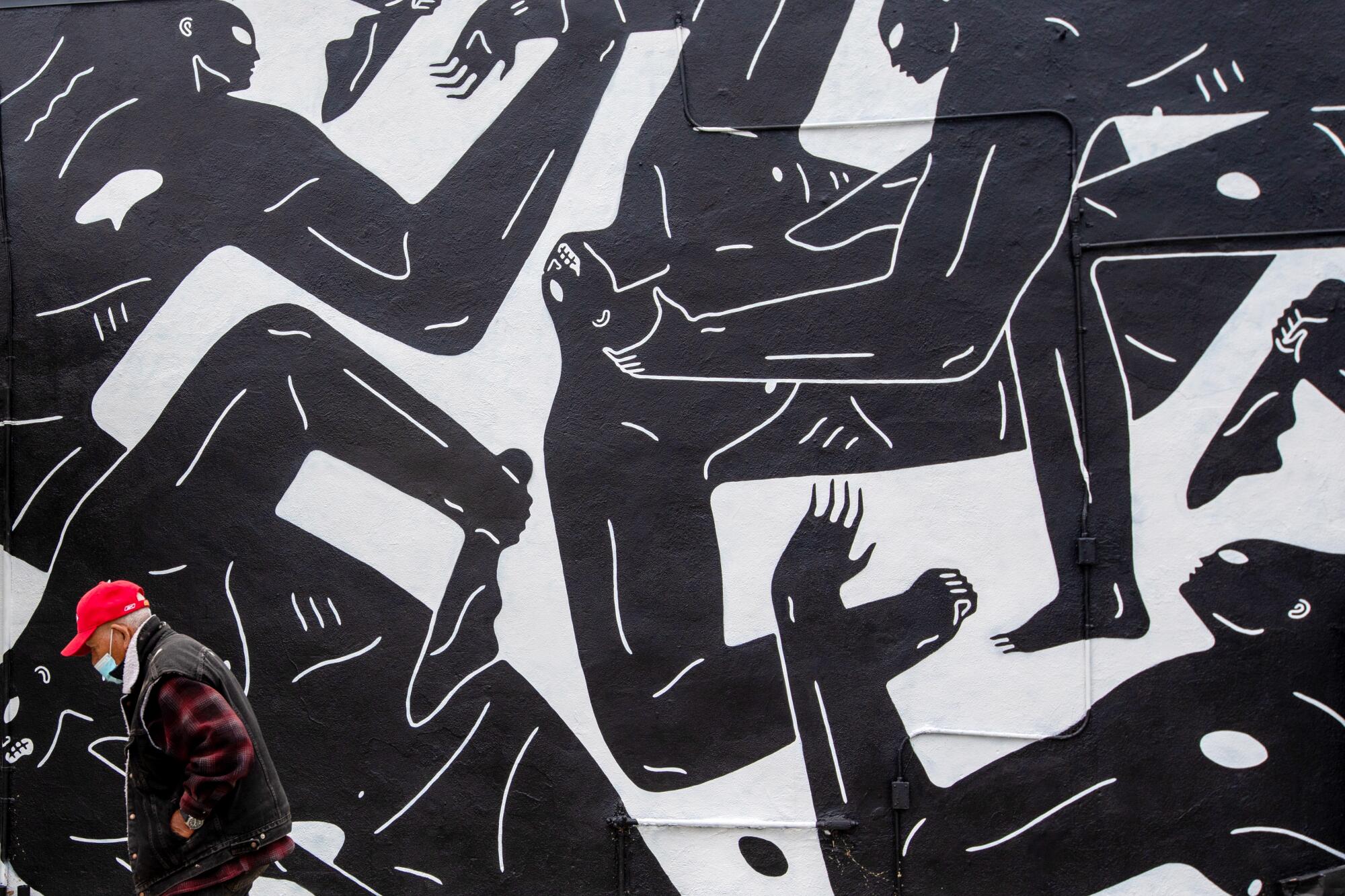
- Share via
It started as an idea to help foster more public art, after a few new murals in the Altadena community were so well-received.
Victor Ving — who worked on the recent Altadena-themed murals — thought the side of Unincorporated Coffee Roasters’ building facing Lincoln Avenue could be the perfect spot to highlight other local, talented artists.
The owners of the local coffee shop jumped on board with the idea, deciding to sponsor a rotating mural project for a new black-and-white design each year.
But when the project’s second installation went up in mid-February, it almost immediately sparked controversy, and even outrage, from neighbors and others in Altadena’s west side. They say the violent image of broad-shouldered figures engaged in conflict, some using weapons, is triggering and offensive — especially for an area that for decades dealt with dangerous gang wars and violence.
“I don’t believe in censoring art, I don’t believe in canceling art, but I believe there’s a place for every art piece — this is not the place,” said Shé Shé Yancy, whose home sits feet from the public mural. “It’s a gut punch every time I pull in and out of my driveway because I’m reminded of the nightmare of the gangs.”
Yancy and a growing crowd of neighbors are calling to have the mural taken down.
A mural commissioned by Metro for the Purple Line station being built on the Department of Veterans Affairs’ West Los Angeles campus has aroused the ire of veterans groups.
But the coffee shop owners and the mural’s artist stand by the work, calling it a provocative piece intended to prompt conversation, introspection and is subject to everyone’s unique interpretation.
“I can’t be the guardian of subjectivity. It’s not my job to tell people how to interpret art,” said Cleon Peterson, the muralist who lives in Altadena. “I try to be a positive influence. I’m not trying to hurt people. ... [But] any good art causes a reaction in people.
“I think it’s a measure of something that is impactful,” he said.
The piece showing figures using knife-like objects is the latest in a long line of public art that has sparked fierce scrutiny — forcing community leaders to try to strike a balance between creative freedom and sensitivity. In recent years, officials at a Chula Vista charter school covered an image showing former President Trump’s bloody, severed head for being too violent, and in Koreatown, neighbors successfully lobbied for a school mural to come down because it reminded some of the Japanese Imperial battle flag from World War II.
“It’s a never-ending debate. This happens worldwide, in every neighborhood,” Ving said. “It’s public art; not everyone will be happy about it.”
The giant image of Ava Gardner on the outer wall of a public school gym in Koreatown speaks to history.
The concerned residents have gone to the town council to seek reprieve, but council members say they have no authority over the mural.
“For better or worse, the county has very loose restrictions on the type of murals that can be displayed here,” said Altadena Councilmember Chris O’Malley, who represents the district with the mural.
He said the council is working to conduct a more thorough survey of residents who live near the mural to determine if further action should be taken.
Cheri Costley, who lives not far from the mural, said the violence in it hits too close to home. Her nephew died in a gang-related shooting in 2011, not far from the mural, and years earlier her sister died after her home — just down the street — was in flames from a Molotov cocktail, part of what officials at the time called a deadly gang war in Los Angeles’ suburbs.
“For us to be healing from all the gang violence and for this to come up and be violent,” Costley said. “I don’t believe that it’s for this community.”
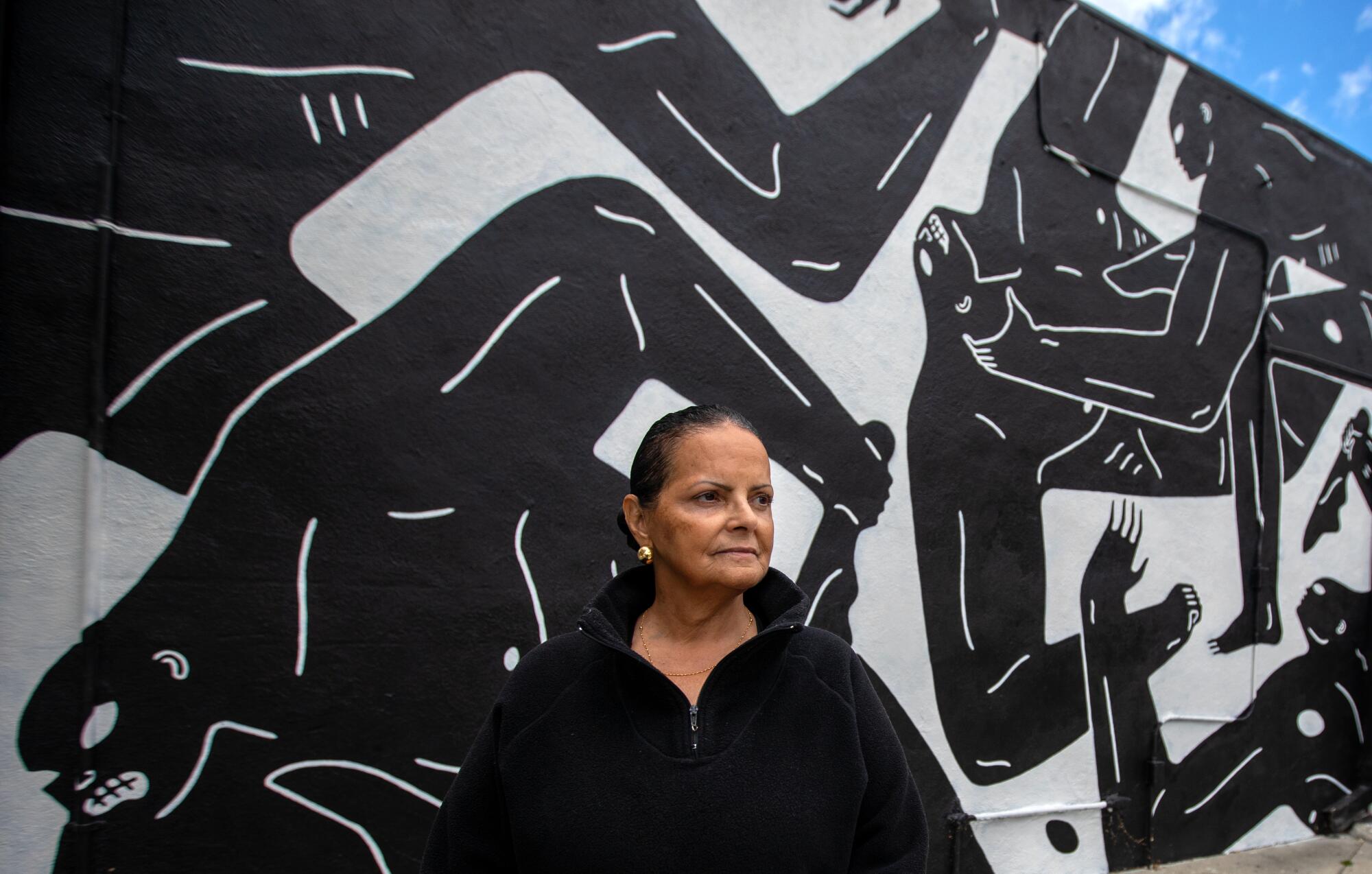
Yancy, a lifelong Altadena resident, said her family also experienced violence while living in the area. She said she worries how such a piece could affect the community, especially young children who often pass the mural heading to and from two nearby schools.
“I hate talking about it, but the Altadena Blocc Crips ruled this area. ... We lived it,” said Yancy, who remembers decades of living in fear of gang violence. “As a Black person, I take offense to it. I see men who are painted black, stabbing and killing each other.”
You’ve heard of the great outdoors, but what about the great artdoors?
Yancy said she was open to compromise, reaching out to the coffee shop owners and the artist, asking if the image could be displayed without the weapons. She and her neighbors have offered to pay to have it painted over, but the coffee shop owners said they have no plans to change the piece until its year installation is up.
“For those unhappy with the work, the mural changes annually to promote local art in our neighborhood,” the owners of Unincorporated Coffee Roasters wrote in a recent statement. “We strive to feature different styles and artists with different points of view. ... We acknowledge that Cleon [Peterson’s] work can be interpreted differently than intended but we stand by his artistic expression and encourage the conversations that arise from the art.”
Peterson’s work has been featured worldwide, and he even has a very similar mural on the side of Brooklyn Bagel Bakery in Historic Filipinotown, which has remained on display for more than three years. Yancy said she has nothing against his work and acknowledges his talent, but wishes he had chosen a more positive piece for her neighborhood, like the one he painted underneath the Eiffel Tower in Paris — which depicts similar-style figures, but intertwined in different ways without weapons.
“I can’t be the guardian of subjectivity, it’s not my job to tell people how to interpret art. I try to be a positive influence, I’m not trying to hurt people. ... [But] any good art causes a reaction in people.”
— Cleon Peterson, whose mural is on the side of Unincorporated Coffee Roasters in Altadena
Peterson said he empathizes with people’s past trauma, but said his piece is almost mundane compared with the amount of other violence in the world, whether in video games or on the nightly news.
“It’s a bummer, and I feel a little bit like I’m the one being attacked,” Peterson said. “I just tried to do something nice in the neighborhood.
“Whenever you do anything in this world there’s going to be criticism — I try to do what I think is right,” he said.
He said his work is a social criticism on power and violence, and isn’t intended to incite anything but conversation or reflection.
“The idea is to look at the image and look within ourselves and look at our own actions,” he said. “The work is about power, and in a way, this kind of initiated a conversation about power in the neighborhood. ... In a sense it’s done its job.”
Ving, who is working to help identify artists for the shop’s murals, said he’s modified the project’s guidelines to not allow religion, racism or depictions of violence, in addition to profanity or nudity.
“I’m responding to the community already,” Ving said. He said he’s empathetic to community members who have dealt with past violence but also worries about setting a precedent for this project and future art.
“I’m so torn with this,” Ving said. “It starts to tie our hands and not be really representative of the mission of this, which is to give artists creative freedom and foster public art.”
But not all neighbors have been upset by the painting. Rosalinda Hernandez said she often walks to the coffee shop and sometimes will work there for a change in scenery.
She’s not one to get offended, she said, but isn’t surprised some might not like the weapons depicted.
“I could see why other people would be against the mural,” Hernandez said. “I just look at it as art. ... Art is beautiful. I think it’s nice because everybody’s idea of art is very different.”
Ving said no matter how it plays out, he’s hopeful the community can move forward together.
“It’s sparked a discussion and hopefully a positive one in the long run,” Ving said. “Whether or not this stays or goes away, a lesson is learned for everybody. ... It’s provocative, but that’s what art’s supposed to be.”
More to Read
Sign up for Essential California
The most important California stories and recommendations in your inbox every morning.
You may occasionally receive promotional content from the Los Angeles Times.
